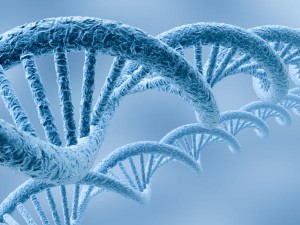The human genome is packed with millions of gene switches that reside in bits of DNA that once were dismissed as “junk” but it turns out that so-called junk DNA plays critical roles in controlling how cells, organs and other tissues behave. Cambridge researchers have published a paper proving that four-stranded ‘quadruple helix’ DNA structures — known as G-quadruplexes — also exist within the human genome. The question is, how many DNA strands are human beings capable of possessing? Some geneticists are claiming humans will one day have 12 strands.
Just a few years ago, modern medicine officially acknowledged the first case of a child with 3 DNA strands. A two-year-old boy, Alfie Clamp became the only person in the world to be diagnosed with an extra strand in his DNA. He was born blind and with severe disabilities, which led doctors to carry out various tests. They revealed his seventh chromosome had an extra strand of material which had never been documented anywhere in the world before. Doctors were baffled at his condition, which is so rare it does not have a name.
Dr. Berrenda Fox said “we are finding that there are other helixes that are being formed. In the double helix there are two strands of DNA coiled into a spiral.” Dr. Fox says there are major changes and mutations occuring in our DNA. We are evolving. “We will be developing twelve helixes. During this time, which seems to have started maybe 5 to 20 years ago, we have been mutating. This is the scientific explanation. It is a mutation of our species into something for which the end result is not yet known,” she stated.
The findings of the G-quadruplexes mark the culmination of over 10 years investigation by scientists to show these complex structures in vivo — in living human cells — working from the hypothetical, through computational modelling to synthetic lab experiments and finally the identification in human cancer cells using fluorescent biomarkers.
The research, published in Nature Chemistry and funded by Cancer Research UK, goes on to show clear links between concentrations of four-stranded quadruplexes and the process of DNA replication, which is pivotal to cell division and production.
Physical studies over the last couple of decades had shown that quadruplex DNA can form in vitro — in the ‘test tube’, but the structure was considered to be a curiosity rather than a feature found in nature. The researchers now know for the first time that they actually form in the DNA of human cells. Quadruplex DNA is actually found fairly consistently throughout the genome of human cells and their division cycles
The study showed that if an inhibitor is used to block DNA replication, quadruplex levels go down — proving the idea that DNA is dynamic, with structures constantly being formed and unformed.
The researchers also previously found that an overactive gene with higher levels of Quadruplex DNA is more vulnerable to external interference.
Scientific research has now proven our DNA holds the genetic codes for our physical and emotional evolution through frequency held in the languages we speak.
There is evidence for a whole new type of medicine in which DNA can be influenced and reprogrammed by words and frequencies WITHOUT cutting out and replacing single genes.
Russian researchers’ findings and conclusions are simply revolutionary! According to them, our DNA is not only responsible for the construction of our body but also serves as data storage and in communication. The Russian linguists found that the genetic code, especially in the apparently useless junk DNA follows the same rules as all our human languages. To this end they compared the rules of syntax (the way in which words are put together to form phrases and sentences), semantics (the study of meaning in language forms) and the basic rules of grammar. They found that the alkalines of our DNA follow a regular grammar and do have set rules just like our languages. So human languages did not appear coincidentally but are a reflection of our inherent DNA.
The Russian biophysicist and molecular biologist Pjotr Garjajev and his colleagues also explored the vibrational behavior of the DNA. The bottom line was: “Living chromosomes function just like solitonic/holographic computers using the endogenous DNA laser radiation.” This means that they managed for example to modulate certain frequency patterns onto a laser ray and with it influenced the DNA frequency and thus the genetic information itself. Since the basic structure of DNA-alkaline pairs and of language (as explained earlier) are of the same structure, no DNA decoding is necessary.
This finally and scientifically explains why affirmations, autogenous training, hypnosis and the like can have such strong effects on humans and their bodies. It is entirely normal and natural for our DNA to react to language. While western researchers cut single genes from the DNA strands and insert them elsewhere, the Russians enthusiastically worked on devices that can influence the cellular metabolism through suitable modulated radio and light frequencies and thus repair genetic defects.
Through scientific inquiry, research has exposed that only 3% of our DNA is wrapped up in the spiraling double helix strand. During the time of the 75,000 year cycle when we are exposed to the most torsion energy waves and it affects our DNA by reorganizing the 97% “junk” DNA from a 2-strand double helix to a 12-strand helix advancing man in a leap of evolution.
Original Article Found Here: http://myscienceacademy.org/2013/01/23/scientists-finally-present-evidence-on-expanding-dna-strands/







